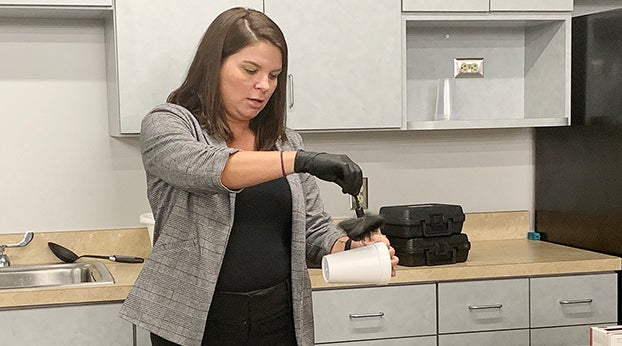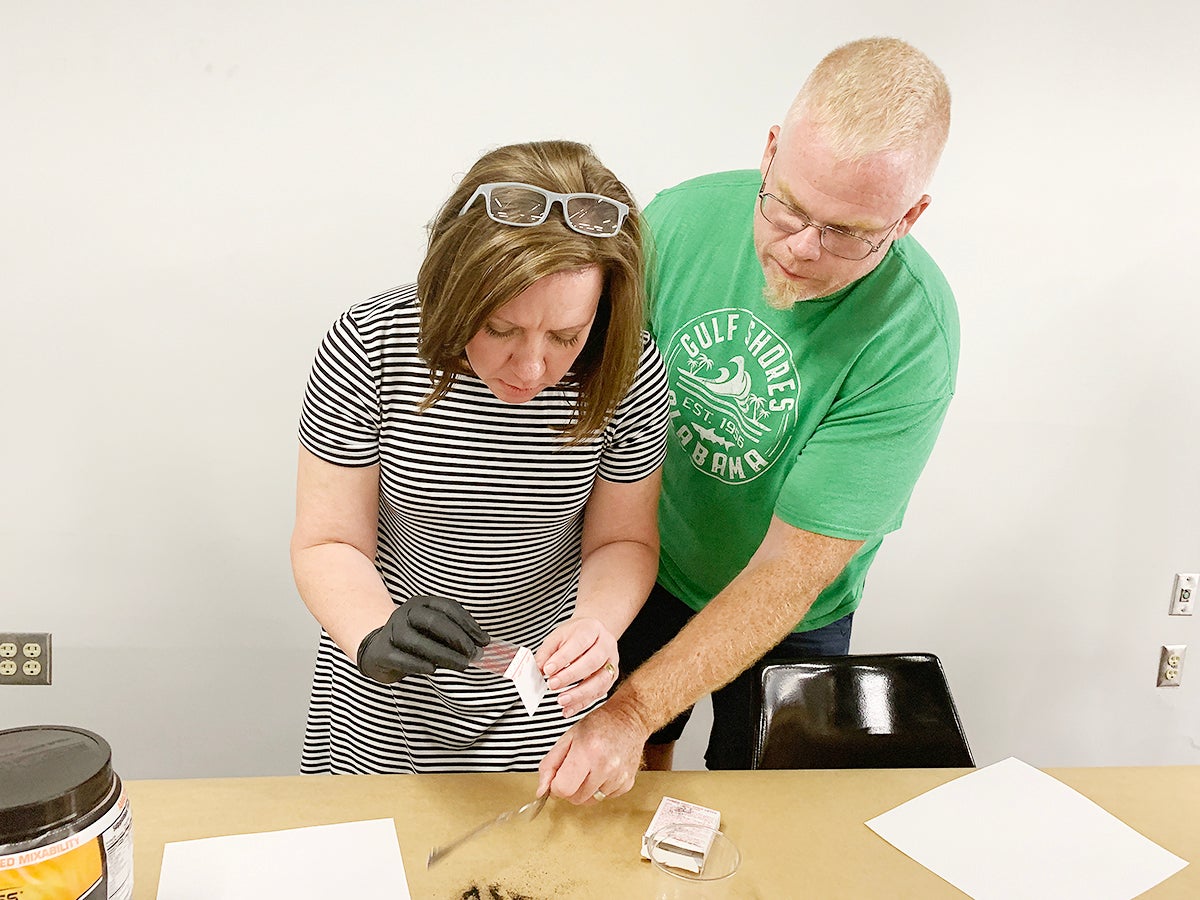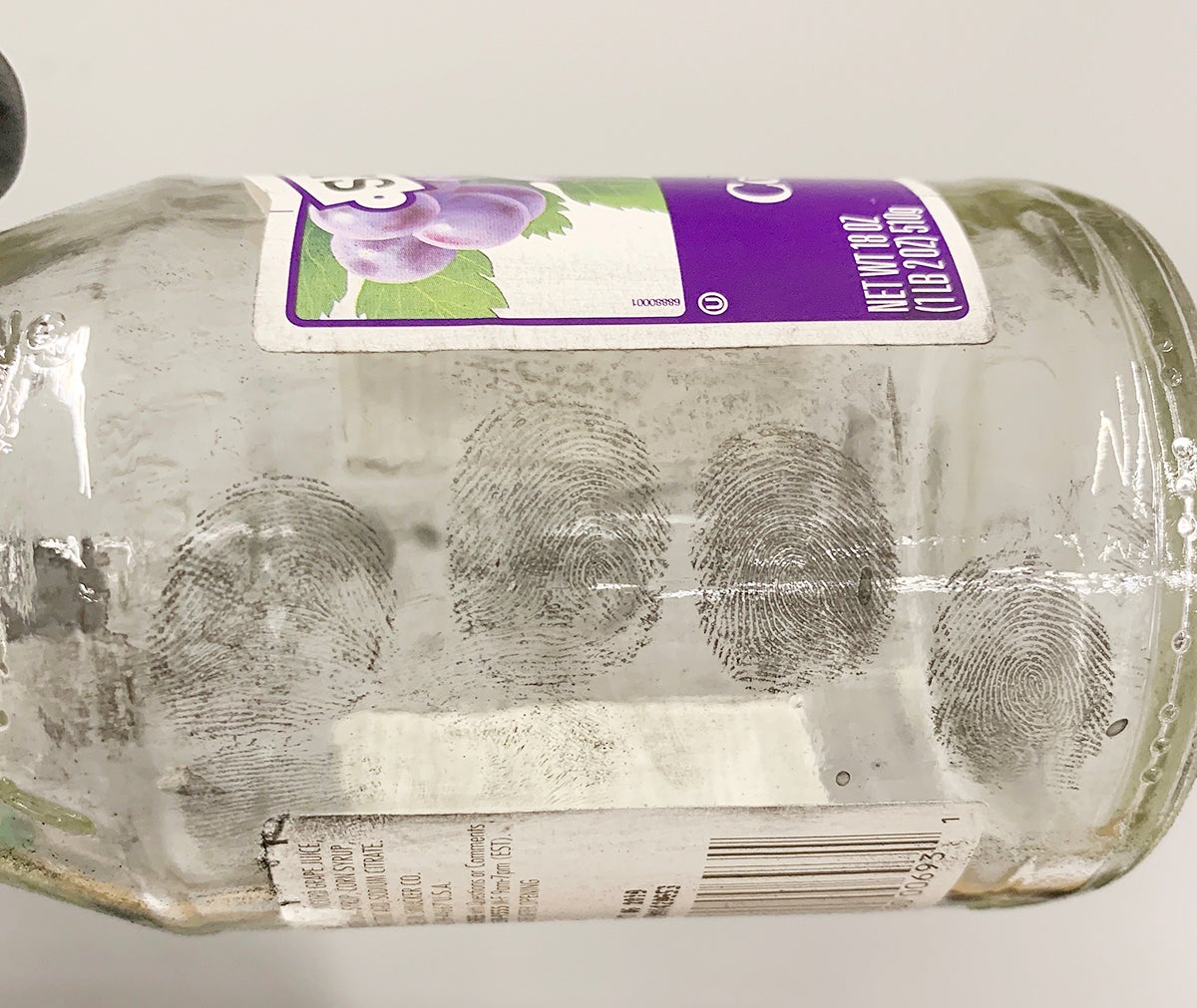Can I be arrested for that?
Officers discuss arrest situations, teach fingerprinting techniques
Published 4:51 pm Friday, September 4, 2020

- Danville Police Detective Lisa Dollins shows members of the citizen police academy how to take fingerprints from an item at a crime scene. (Jeff Moreland photo)
Editor’s note: This is the third in a series of articles written to share the experience of members of the current Danville Police Citizens Police Academy. The 10-week academy will teach the members about all aspects of local police work.

Denise Terry and her husband, Matt Cochran, members of the 2020 Danville Police Citizens Police Academy, work to get a fingerprint from a fork. (Jeff Moreland photo)
It’s easy to assume that if the police come to an incident, a person is going to jail. Sometimes that happens, but many times, it doesn’t because situations simply don’t legally allow a person to be arrested.
Members of the Danville Police Citizens Academy learned Tuesday night about situations when officers can and cannot arrest someone. Capt. Chris Matano talked to the class and explained the three types of offenses, which are violations, misdemeanors and felonies.
Matano and Assistant Police Chief Glenn Doan explained when situations in either category do or do not allow officers to arrest a subject.
“You’d be surprised the amount of calls we get where no police action can be taken,” Doan said. “A lot of times we’re just giving them legal advice – you need to speak with an attorney, you need to go to civil court. Those are a big part of our day, of people believing something is criminal in nature when it’s actually civil.”
One of those instances is custody situations with children, and this doesn’t fall under either of the three categories. Doan said situations involving custody of a child are often misunderstood, and police are almost always called to deal with the complaint. He said people often misunderstand that if one parent doesn’t follow through on a custodial exchange, the other parent is guilty of kidnapping. He stressed that is not the case.

Fingerprints can be seen on the side of a jelly jar after applying powder. (Jeff Moreland photo)
“If a parent doesn’t exchange the child, they want to call us for kidnapping. Most of the time, those are just violations of custody agreements,” he said. “Those parents have equal rights, and they’re violating an agreement set forth in court. I can’t arrest them for contempt of court or a judge’s order. I definitely can’t arrest them for kidnapping or anything like that. Those things have to go to family court. That’s not our responsibility, but the person that gets called to sort through it is always going to be us, so we do.”
Matano explained some of the times when officers have the right to arrest someone.
“We can arrest for any misdemeanors or any felonies that occur in our presence. We can arrest for felonies that are not committed in our presence, but we believe they occurred based on probable cause that we have gained. We can also arrest on an arrest warrant issued by a judge at any time,” he said.
Due to overcrowding issues in jails, House Bill 463 came about in 2011, according to Matano. He said the bill “handcuffed us big time” on arrest situations that don’t happen in the presence of an officer. Still, he said there are four situations involving misdemeanors when an arrest can be made, even if the incident doesn’t happen in the presence of an officer.
The first is shoplifting. If a store’s loss prevention staff sees a person shoplifting, they can contact police and that person can be arrested, even though the crime is a misdemeanor. Domestic violence is another instance when an arrest can be made without an officer seeing the crime take place. Matano said if one person, such as a husband or wife, reports being assaulted by the other, officers can arrest the offender, and will usually do so to “err on the side of caution.”
A person driving under the influence, committing a DUI, can be arrested for the crime without an officer witnessing the incident. Doan explained that if there is probable cause, such as witnesses reporting that a person who is intoxicated was driving a vehicle, that person could be arrested for DUI.
Violation of an emergency protection order, or EPO, is also an arrestable offense, even if an officer doesn’t witness it. Matano said if there is an EPO in place, and officers get a call that someone has been at their home in violation of that order, and police stop them down the road, they can be arrested for violation of the EPO.
There are situations when people tend to believe an arrest should be made, but according to law, cannot. Matano said in a simple assault, such as two friends who are fighting, it will not usually end in an arrest. Typically, he said the parties will be cited to appear in court.
Doan said as an example, if a person is walking down the street and someone walks up and punches them, giving them a bloody nose, but doesn’t cause serious injury, that person cannot be arrested.
“I’ll do a report, I can help you file charges, but I couldn’t charge him and arrest him,” he said. “That person is jumping up and down asking, ‘Why don’t you take him to jail?’ It’s not a domestic-related assault – they’re not in a relationship, they’re not family. I can’t arrest him, I can give him a ticket to court for that, a citation for assault fourth. That’s not going to make the victim happy, but we can’t arrest the person.”
Arrests most often result from a felony, such as theft over $500, burglary, murder and other serious crimes. Matano said several drug-related offenses are also felonies, as are fleeing police, assaulting police, EMTs, firefighters, or rescue squad members.
Although arrests don’t normally come from violations, which are less-serious offenses, there are three instances when a person can be arrested for a violation.
Matano said the first is alcohol intoxication. A person arrested for alcohol intoxication in public would usually go to jail for 6 to 8 hours to sober up, and then be released, he said. Doan added that a person is arrested in this situation primarily because of liability by the police department. He said if a person was allowed to go on their way after an officer knew they were intoxicated, and then injured themselves or someone else, the city would possibly be liable and could be sued.
“That’s why a lot of times we’re not playing this game, call somebody, get a ride. Sometimes, it’s situational, but usually, the best option is to go ahead and arrest this person,” Doan said.
Criminal trespassing 3rd degree is another violation that can lead to arrest. Doan said this involves a person entering a premises, such as climbing over a fence onto property. The third is reckless driving, with speeding more than 26 miles per hour over the speed limit.
Doan said officers do not usually arrest for reckless driving. He said arrests usually come when the situation rises to the level of wanton endangerment, such as running other cars off the road.
“There’s probably going to be other charges than reckless driving in those cases,” he said.
Police departments will set up traffic checkpoints for DUIs from time to time, but Matano said it’s not as simple as just deciding to do it. He said they have to announce the checkpoint to the public in advance and give a general location and time, although they are not required to tell exactly when and where the checkpoint will be operating. A checkpoint is governed by law, and must meet requirements such as being well lighted and visible from a certain distance, as well as having a traffic cone pattern set up before vehicles reach the checkpoint.
Doan said despite what many people believe, police officers cannot stop a vehicle for avoiding a checkpoint.
“Just because you turn around and go the opposite way, that is not a legal reason for us to pull you over. Now, if you do a U-turn and about get hit by three other cars and squeal tires, now you’re committing other traffic violations,” he said. “If you were followed after turning away from a checkpoint, you would still have to commit another traffic violation before we can pull you over.”
He added that drivers will often avoid checkpoints, thinking the lights ahead indicate an accident.
“They think it’s a wreck. And there’s 800 different ways to get everywhere in Danville, and if I want to go the other way, that’s fine,” he said.
Doan said police departments receive grants from the National Highway Safety Administration for conducting the checkpoints, and he added that they aren’t actually used to catch impaired drivers.
“We do two a year for the grant, but it’s very rare that you actually get a DUI in them,” he said. “They are more for contact and education. It’s a great PR tool. We check your stuff and you go on. It’s a positive interaction with the police. That’s really the biggest thing it’s used for.”
Detectives on duty
Danville Police Department has four detectives, and two of them, Det. A.J. Mullins and Det. Lisa Dollins, talked to the class. Dollins said detectives interview people in cases, whether it’s a suspect or a victim. She said detectives take classes for interviewing, and they learn about things to look for such as body language and other actions. The only requirement is that the person has served on the force for at least two years. From there, it’s just finding someone who fits what the department is looking for in a detective.
“When we’re looking to bring a new detective in, we’re really looking for a personality type,” she said. “Somebody who will get along with us, somebody really detail-oriented, somebody who can sit down and type really long reports, because that’s what we do.”
Detectives also interview suspects and victims in cases, and the skill for interviewing is built with experience. Dollins added that they don’t usually rely on just one detective to interview a suspect, and another detective will often watch from another room.
“It can be very difficult if I’m engaged in conversation to notice if you’re fidgeting in a certain way, so have another detective who may watch for that from somewhere else – usually not in the same room,” she said.
Mullins added that an interviewer can also hit a nerve with a suspect but they may not notice how the suspect reacts. In that case, she said the additional detective watching can point out things and recommend they go back and address the issue.
Fingerprinting a scene
Anyone watching crime shows on TV can be led to think fingerprints are everywhere, and with them, police can easily solve a case in a short time. Doan said that’s not how it works in real life.
“If your home gets burglarized and you wonder why we never solved it, even though we have all of this great evidence like you see on TV. We’ll show you how, in real time, some of those things go and how difficult that processing can be.
“If you’ve got a fingerprint unless it’s a fingerprint from a murder – I’ve got fingerprints back two years after they’ve been submitted for burglaries or non-violent crimes. We’re still waiting for DNA results from a bank robbery. We tried to submit it to an FBI laboratory, but they don’t have time to deal with that,” he explained.
Dollins said AFIS, or the automated fingerprint identification system, has a backlog of as much as two years, and if fingerprints are submitted in a case where officers don’t have a suspect, it can be nearly impossible to get results from fingerprints.
The surface where a fingerprint is found can be a huge factor in getting a good print. Dollins said people think fingerprints can come from any surface, when in fact, a very smooth surface is needed to get a good print that can be used as evidence.
“This table right here would almost be impossible to get prints off of because of that slight texturing it has. It almost has to be a completely smooth surface,” she added.
After demonstrating the methods of gathering prints, which include a powder or a magnetic substance, class members got a chance to go hands-on, literally. After intentionally placing their prints on an item, the members then used the tools and methods taught by detectives to collect and log the print
that could potentially be used as evidence in a case. Some were able to lift prints, while others had more difficulty, and the materials being fingerprinted played a role in the success level.
Next up: Week 4 of the 2020 Danville Police Citizens Academy is scheduled to include techniques for use of force, as well as a demonstration and participation of Krav Maga, a self-defense fighting system often used by military and police agencies.






